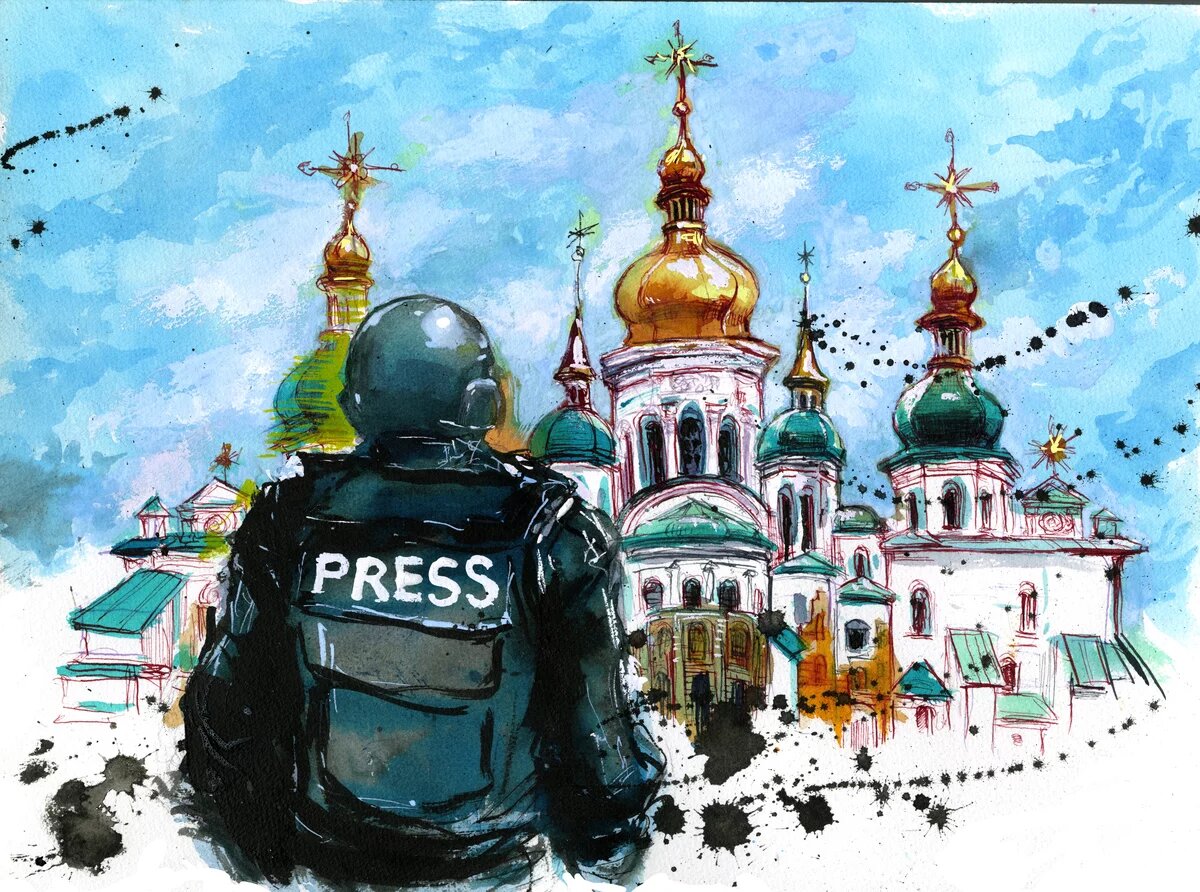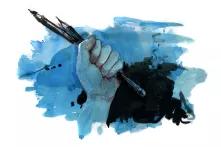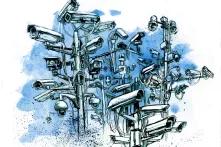The once lively scene of local and national Ukrainian media is threatened by the brutal Russian invasion and occupation. War has changed the work of journalists and media business models are under threat. Today’s task is to preserve the Ukrainian media landscape and keep journalists in the profession. The tragic case of Russia illustrates that without comprehensive freedom of speech and independent media, dictatorship can thrive.

Some Ukrainian media representatives joke that on February 24 all journalists in Ukraine automatically became war correspondents. There is a lot of truth in this joke. Before the full-scale Russian invasion, the team at the Public Interest Journalism Lab (PIJL) was promoting ‘constructive journalism’. We conducted cross-sectoral research, and together with sociologists and analysts, we studied what forms of content help reduce polarization in society.
From February 24 onwards, our team switched to field documentary work - we traveled to almost all regions of the country, recording the realities of the war. Together with lawyers, we collected evidence of numerous war crimes committed by Russian soldiers in order to bring the perpetrators to justice in the future. Some of the cases that we recorded within 'The Reckoning Project: Ukraine Testifies' have already been referenced in a report by the United Nations High Commissioner for Human Rights.
However, along with the people’s suffering and destroyed cities, we have seen hundreds of inspiring examples of resistance, solidarity, and an unconditional faith in victory. We decided to collect these stories about how the war changed the lives of Ukrainians in a modern multimedia chronicle called "Life in War". To record the many stories across the country, we realized that we had to join forces with other journalists who are continuously working on the ground. Today, "Life in War" has more than 30 media partners. Some of our partners were in Russian captivity during the occupation of Kherson, some still risk their lives working undercover in the temporary Russian occupation of the Zaporizhzhia region.
According to the Ukrainian NGO Institute of Mass Information, eight journalists have been killed while carrying out their professional duties (three of them Ukrainian and five foreign) since February 24. Another 34 media workers died as combatants, or as a result of Russian shelling or torture. Some Ukrainian journalists, such as Maksym Butkevych, who decided to join the Ukrainian Armed Forces to defend the country's independence, have been in Russian captivity for several months. Unfortunately, his fate is still unknown.
Many journalists and foreign correspondents are adapting to the extraordinary working conditions in Ukraine: Amid rocket attacks and in bomb shelters, in the absence of electricity and communication, they continue to perform their duties. The workload of journalists has increased manifold. Many Ukrainian newsrooms have been working without leave for nine months, while their income has significantly decreased because the advertising market as a source of funding for independent media in Ukraine has dried up. As a result, some newsrooms had to lay off staff. However, the vast majority continue their important work despite all obstacles. Overcoming psychological trauma and fatigue, they work to let the world know the truth about this war.
Resilient media: adaptation and solidarity
Informing people about urgent threats or current developments, Ukrainian media ought to remain a safeguard against undue centralization or any potential usurpation of power within the country. Journalists, in conjunction with civil society, should ensure that temporary censorship or self-censorship by journalists due to martial law does not become the norm and does not turn into political censorship. Covering the war, journalists must adhere to certain rules established by the General Staff of the Armed Forces of Ukraine. For security reasons, there are certain restrictions on covering the consequences of enemy shelling. It is also prohibited to publish detailed information on the movement of Ukrainian troops and access to the front line is strictly regulated. In times of war these limits are understandable, and nine months into the war, journalists have adapted to them.
Another particularity of the war coverage is the fact that with the format “United News”, commercial TV channels and the public broadcaster have started to broadcast together, instead of airing their own programs. Practically all TV workers are now working to create news. The fact that such a cooperation is possible has become a positive precedent in itself. In the past years, all major TV channels were owned by oligarchs and competed with each other, thereby upholding what experts dubbed ‘oligarchic pluralism’. Many of them were fiercely critical of the Zelenskyy government. Thus, questions remain how the ability of TV channels and (non-)oligarchic media to criticize the ruling power can be restored after the war.
At the same time, Ukrainian media are facing the acute issue of finding new forms of content to cover the war. After nine months of horrors, there is a certain news fatigue by the audience, a limit to the perception of trauma, because Ukrainians learn about the atrocities of war not just from TV and newspapers, but – first of all – from their own experience. Therefore, in the summer, some online media began to return to the formats, which they published before February 24 – for example, to cultural news and extensive interviews with intellectuals, or journalistic investigations, such as the article of ‘Ukrainska Pravda’ on the luxury lifestyle of Kyrylo Tymoshenko, deputy head of Ukraine’s Office of the President. Journalists say that in this way they respond to the audience's request to integrate the current war context into these topics.
Solidarity is also lived on the Ukrainian media frontline. Many newsrooms and individual journalists share life hacks about adaptation with each other. Another element of joint survival was to hold numerous training sessions for journalists (from first aid to psychological resilience), and the emergence of resource hubs for media professionals. For example, the Institute of Mass Information launched 10 regional media hubs to support journalists in war. In these secure resource centers, Ukrainian and foreign journalists can rent equipment, work and transmit data, cooperate with each other, and study.
The lost advertising revenue has been replaced by other forms of funding. Grants from international organizations, fundraising, native advertising on the internet, collecting donations through Patreon, etc., help Ukrainian media to stay afloat. Unfortunately, not all of them could be saved. We are grateful for this support, but demand continues to grow, especially from small regional outlets that have no experience in fundraising, yet they are the only source of information about their towns.
Our organization supports many of them through the ‘Life in War’ media partnership, because even through providing an amount of 5,000 euro, we can ensure the survival of such an editorial office for several months. Nevertheless, the fact remains that today, the Ukrainian media need more support from the donor community – flexible and long-term support that will allow them to plan their activities and perform their professional duties under the extremely difficult conditions of war. Our common task today is to preserve Ukrainian media and safeguard journalists because we witness their value every day. Moreover, the example of Russia shows how the lack of freedom of speech and independent media gives rise to dictatorship.
Before the tanks invade, disinformation has long taken root
Since 2014, Ukrainian civil society organizations, including the PIJL, have been documenting numerous cases of Russian fake news, disinformation, and manipulation, and how they are disseminated in the Ukrainian media space. Ukrainian law enforcement agencies have uncovered large-scale bot farms several times over the past two years, and the websites of leading Ukrainian media outlets are regularly subject to DDOS attacks.
According to research by our colleagues from the NGO ‘Detector Media’, today, the most dangerous channel for spreading Russian fake news in Ukraine is Telegram, which is also one of the most popular channels for receiving daily news for Ukrainians. The unwillingness of Telegram’s owners to respond to disinformation has made this network a safe harbor for fake news and propaganda. One of Telegram’s main features is that the authors of so-called ‘channels’ are completely anonymous. This enables widespread impersonation, which was a deliberate strategy employed by Russia in the first days of the full-scale invasion of Ukraine. Detector Media researchers found that a network of fake Telegram channels for Ukrainian cities was created to promote separatist ideas both in the temporarily occupied territories and in free Ukrainian cities, under the guise of pretending to be local media. Even now, there are at least 300 popular channels in the Ukrainian segment of Telegram that spread disinformation narratives of Russian propaganda.
In Ukraine, specialized civil society organizations have already been dealing with disinformation for eight years with advanced experience. There are many open training courses and lectures on media literacy, designed to learn how to distinguish fake and truthful information, and to not succumb to the influence of psychological operations of the enemy (PSYOPs), because Ukrainians understand the harm that panic can cause.
However, Ukraine is not the only battlefield for Russia’s disinformation troops. Therefore, we need to ask: Do European societies treat this threat with the same seriousness? Are they ready to respond more decisively to the massive channels of disinformation that label themselves Russian media? If the content they disseminate is not intended to inform, and they are not media organizations by nature, then why should they be protected by the same rights as those that adhere to professional standards? Our colleagues in EU countries in particular should take a closer look at their own information spaces. We need joint decisions on the ‘Kremlin's trumpets’ that are working every minute to undermine the foundations of liberal democracy and polarize our societies.
Let us start by calling it like it is and stop using ambiguous or openly pro-Russian narratives. Language matters. This is not the ‘Ukrainian war’, not ‘the war in Ukraine’, and not ‘Putin's war’. It is an ‘unprovoked war of aggression by Russia against Ukraine’. And to be sure, for Ukrainians, this war is not only informational. The horrors committed by Russia have moved far beyond the battlefield of disinformation. The mission of a journalist in this war is to defend the truth and shed light on these events so that the perpetrators can be brought to justice and history is written truthfully.


